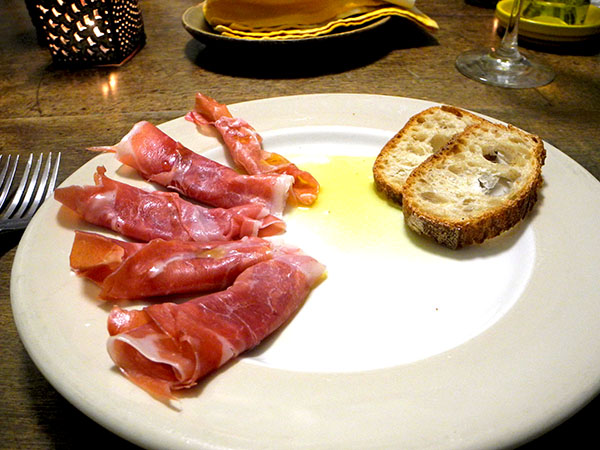
An antipasto doesn’t get much more simple than this, and the primi was only a little more elaborate.

Both pretty Italian, they seemed made for each other on a cool evening.
The salume was actually American (although not local), and, as always with this product, really good! The recipe (which was local) that I used for the pasta was also, technically, American: Mark Bittman’s ‘Linguine With Walnuts And Anchovies’. My only alterations were these: using a pasta that I already had; introducing a bit of a heatless dark dried pepper to the sauce; and garnishing it with the last of a wonderful ‘micro ‘green’ that still remained in the refrigerator yesterday.
- three ounces of La Quercia Prosciutto Americano from Whole Foods, drizzled with a little good Campania olive oil (Lamparelli O.R.O.)
- served with slices of a Bien Cuit baguette from Foragers Market
- the pasta was Afeltra spaghetto, from Eataly; the shelled walnuts from Whole Foods; the garlic was from John D. Madura Farms; the red pepper was less than half of one dried Itria-Sirissi chili, peperoncino di Sardegna intero from Buon Italia; the heatless pepper was a home-dried, dark mahogany in color Habanada (which had been purchased fresh from Norwich Meadows Farm last fall); the 4 large Agostino Recca salted Sicilian anchovies, which were rinsed well and filleted, were from Buon Italia, in the Chelsea Market; and the garnish was micro red amaranth from Windfall Farms
- the wine throughout was a southern Italian (Campania) white, Feudi Di San Gregorio Falanghina 2014
- the music was also Italian, or perhaps more precisely, Sicilian, composed by Palermo-born Salvatore Sciarrino; there were 2 works: ‘Un’ immagine d’Arpocrate‘, with pianist Tamara Stefanovich, Susanna Mälkki conducting the Bavarian Radio Symphony Orchestra, and Florian Helgath directing Chorwerk Ruhr; and ‘Giono velato presso il lago nero‘, with violinist Carolin Widmann, Jonathan Nott conducting the Bavarian Radio Symphony Orchestra










